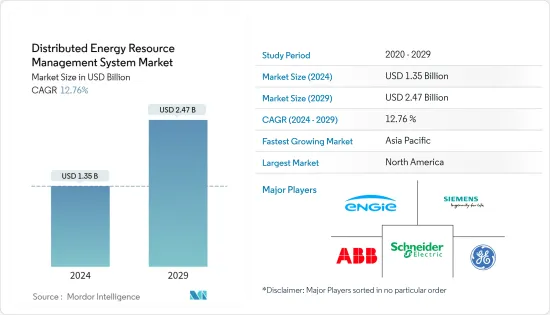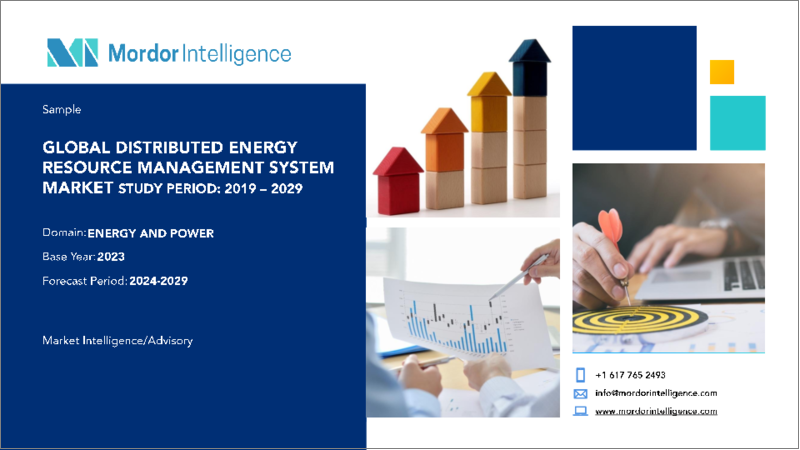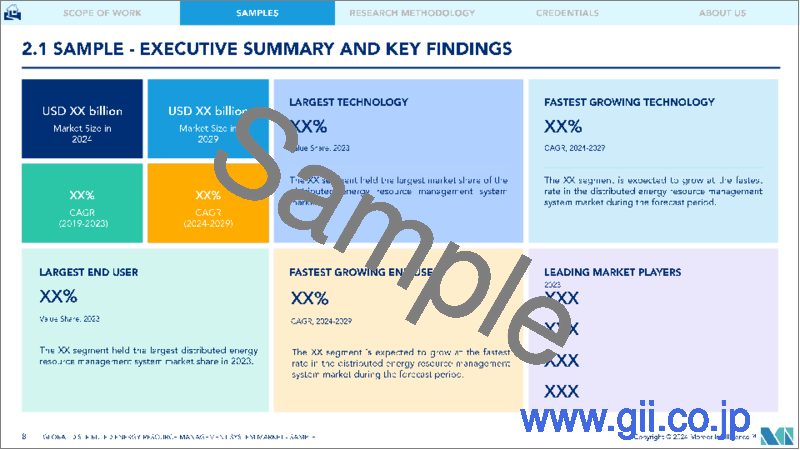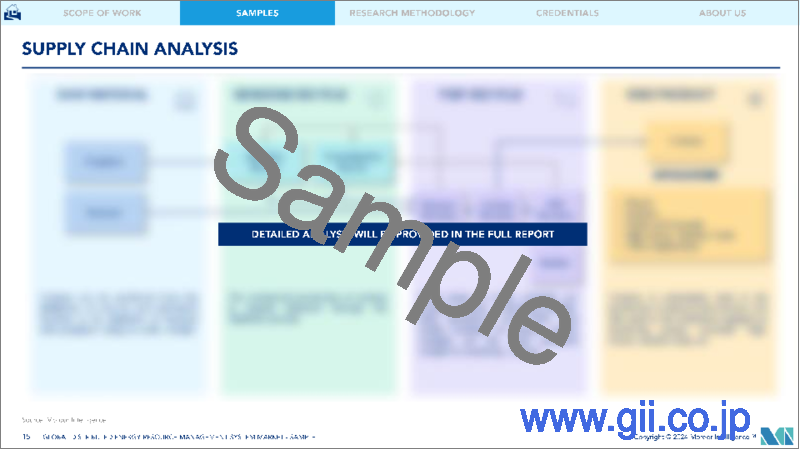|
|
市場調査レポート
商品コード
1440203
分散型エネルギーリソース管理システム:市場シェア分析、業界動向と統計、成長予測(2024~2029年)Distributed Energy Resource Management System - Market Share Analysis, Industry Trends & Statistics, Growth Forecasts (2024 - 2029) |
||||||
|
● お客様のご希望に応じて、既存データの加工や未掲載情報(例:国別セグメント)の追加などの対応が可能です。 詳細はお問い合わせください。 |
|||||||
| 分散型エネルギーリソース管理システム:市場シェア分析、業界動向と統計、成長予測(2024~2029年) |
|
出版日: 2024年02月15日
発行: Mordor Intelligence
ページ情報: 英文 125 Pages
納期: 2~3営業日
|
- 全表示
- 概要
- 目次
分散型エネルギーリソース管理システムの市場規模は、2024年に13億5,000万米ドルと推定され、2029年までに24億7,000万米ドルに達すると予測されており、予測期間(2024年から2029年)中に12.76%のCAGRで成長します。

主なハイライト
- 中期的には、効率的なエネルギー管理システムに対する需要の増加や再生可能エネルギー源の普及の増加などの要因が、予測期間中の分散型エネルギーリソース管理システム(DERMS)市場の最も重要な促進要因の1つになると予想されます。
- 一方で、DERMSの導入には初期費用がかかります。これは、予測期間中に分散型エネルギーリソース管理システム(DERMS)市場に脅威をもたらします。
- それにも関わらず、アジア太平洋地域やアフリカ地域の低電化地域における分散型発電の導入は、近い将来に市場のチャンスとなることが期待されています。
- 北米は、分散型発電技術に対する政府の支援政策と、エネルギーミックスにおける再生可能エネルギーの割合の増加により、予測期間中に最大の市場になると予想されています。
分散型エネルギーリソース管理システム(DERMS)市場動向
太陽光発電(PV)部門が市場を独占
- 太陽光発電は屋上または地上に設置でき、世界最大の分散型電源の1つです。このセグメントは、平均設置コスト(USD/キロワット)の低下に支えられて設置容量が増加し、分散型エネルギーリソース管理システムを推進すると予想されます。分散型エネルギーリソース管理システムは、リアルタイムの太陽光発電(PV)出力を制限して、逆流や局所的な高電圧を防ぎます。
- 分散型発電は経済的に実行可能であり、同等の従来の設備に比べて必要な資本が大幅に少なくなります。太陽光発電所と分散型太陽光発電の両方に対する税制優遇措置により、世界中で分散型太陽光発電が推進されています。
- 国際再生可能エネルギー機関によると、2022年の世界の太陽光発電設置容量は1,046.61 GWでした。前年比22.4%の年間成長率と政府の支援的な太陽光発電目標により、太陽光発電容量は増加すると予想されています。将来的には、分散型エネルギーリソース管理システム市場を牽引する可能性があります。
- コスト削減により、中国における太陽光発電の拡大が大幅に促進されると予想されており、その大部分は事業規模のプロジェクトです。分散型太陽光発電の容量も、商業用および産業用の新たなオークションや住宅システムに対する補助金によって急速に増加すると予想されています。
- インドの太陽光発電設備は2022年に62.8GWに達し、2021年の4934万kWから増加しました。合計には事業規模、屋上太陽光発電、分散型発電の太陽光発電容量が含まれます。したがって、分散型電源としての太陽光発電の採用の増加に伴い、分散型エネルギーリソース管理システムの需要が増加すると予想されます。
- インドは2030年までに約280ギガワットの太陽光発電を発電するという野心的な計画を立てており、太陽電池モジュールの現地製造を促進するためにさらに19,500カロールインドルピーを支出する計画を概説しました。米国では、企業の調達に支えられ、太陽光発電への投資が大幅に増加しました。
- したがって、太陽光発電への投資の増加と政府規制の変化に加え、今後のプロジェクトにより、太陽光発電セグメントは予測期間中に最大の市場になると予想されます。
北米が市場を独占する
- 北米は、2022年のDERMS市場をリードしました。さらに、100万台を超える分散型発電ユニットを米国とカナダの支援を受けて、予測期間中に最大の市場になると予想されています。
- 十分な発電量と送配電網の利用可能性にもかかわらず、洪水や暴風雨などの自然災害により、地域の一部の地域で停電が発生しています。分散型エネルギーシステムを調整するためにDERMSなどの遠隔電力システムを使用すると、この問題が軽減される可能性があります。
- 分散型太陽光発電は、初期コストが比較的低く、サービスコストが削減されるため、大幅な成長が見込まれており、投資収益率が短くなります。カリフォルニアやテキサスなどの多くの州は、屋上太陽光発電の設置など、再生可能エネルギーを統合するためのいくつかの法律を導入しており、市場の成長を促進すると期待されています。
- 2022年の時点で、カナダの300以上の遠隔地コミュニティは、エネルギー安全保障、環境衛生、経済成長を制限する発電インフラに依存しています。従来の中央発電機と比較して、分散型発電システムの承認と開発のプロセスが迅速であるため、特に遠隔地で老朽化したインフラストラクチャの使用を補完し、拡張するための迅速な電気システムの設置が容易になります。
- 北米の電力会社の多くは、配電システム内の資産を管理および制御するためのより良い方法を必要としています。分散型エネルギー資源(DER)の高い普及率は、排出目標を達成し、より高いエネルギー需要に対応する上で重要な役割を果たすことになります。
- 国際再生可能エネルギー機関によると、米国は2022年に111.53ギガワット(GW)の太陽光発電容量を設置し、2021年の93.91 GWを上回りました。これにより、分散型エネルギーリソース管理システムの需要が創出されると予想されます。
- したがって、これらの要因に基づくと、予測期間中に北米が分散型エネルギーリソース管理システムの最大の市場となる可能性があります。
分散型エネルギーリソース管理システム(DERMS)業界の概要
分散型エネルギーリソース管理システム市場は半分細分化されています。市場の主要企業には(順不同)、General Electric Company、Siemens AG、ABB Ltd、Schneider Electric SE、Engie SAなどがあります。
その他の特典
- エクセル形式の市場予測(ME)シート
- 3か月のアナリストサポート
目次
第1章 イントロダクション
- 調査範囲
- 市場の定義
- 調査の前提条件
第2章 エグゼクティブサマリー
第3章 調査手法
第4章 市場概要
- イントロダクション
- 2028年までの市場規模と需要予測(USD)
- 最近の動向と発展
- 政府の政策と規制
- 市場力学
- 促進要因
- 効率的なエネルギー管理システムに対する需要の高まり
- 再生可能エネルギー源の普及拡大
- 抑制要因
- DERMSのセットアップにかかる高額な初期コスト
- 促進要因
- サプライチェーン分析
- ポーターのファイブフォース分析
- 供給企業の交渉力
- 消費者の交渉力
- 新規参入業者の脅威
- 代替製品やサービスの脅威
- 競争企業間の敵対関係の激しさ
第5章 市場セグメンテーション
- テクノロジー
- 太陽光発電(PV)
- 電気自動車
- マイクログリッド
- その他の技術
- エンドユーザー
- 産業用
- 住宅
- コマーシャル
- 地域(地域市場分析{2028年までの市場規模と需要予測(地域のみ)})
- 北米
- 米国
- カナダ
- 北米のその他の地域
- 欧州
- ドイツ
- ロシア
- フランス
- 英国
- その他欧州
- アジア太平洋
- インド
- 中国
- シンガポール
- その他アジア太平洋地域
- 南米
- ブラジル
- チリ
- アルゼンチン
- その他南米
- 中東とアフリカ
- アラブ首長国連邦
- イスラエル
- ジョーダン
- その他中東およびアフリカ
- 北米
第6章 競合情勢
- 合併と買収、合弁事業、コラボレーション、および契約
- 有力企業が採用した戦略
- 企業プロファイル
- General Electric Company
- Siemens AG
- ABB Ltd
- Schneider Electric SE
- Engie SA
- AutoGrid Systems Inc.
- Doosan Corporation
- Open Access Technology International Inc.
- Mitsubishi Electric Corporation
- Emerson Electric Co.
第7章 市場機会と将来の動向
- 低電化地域における分散型発電の導入
The Distributed Energy Resource Management System Market size is estimated at USD 1.35 billion in 2024, and is expected to reach USD 2.47 billion by 2029, growing at a CAGR of 12.76% during the forecast period (2024-2029).

Key Highlights
- Over the medium term, factors such as increasing demand for efficient energy management systems, and increased penetration of renewable energy sources are expected to be one of the most significant drivers for the distributed energy resource management system (DERMS) market during the forecast period.
- On the other hand, high initial cost of setting up DERMS. This poses a threat to the distributed energy resource management system (DERMS) market during the forecast period.
- Nevertheless, the adoption of distributed power generation in the low-electrified areas of the Asia-Pacific and African regions is expected to act as an opportunity for the market soon.
- North America is expected to be the largest market during the forecast period, owing to supportive government policies for distributed power generation technology and the increasing share of renewables in the energy mix.
Distributed Energy Resource Management System (DERMS) Market Trends
Solar Photovoltaic (PV) Segment to Dominate the Market
- Solar PV can be located on rooftops or ground-mounted and is one of the largest distributed power sources globally. This segment is expected to drive the distributed energy resources management system with increased installed capacity supported by decreasing average installed cost (USD/kilowatt). Distributed energy resource management systems limit real-time photovoltaic (PV) output to prevent reverse flows and high local voltages.
- Distributed generation is economically viable, requiring significantly less capital than an equivalent traditional facility. Tax incentives for both solar stations and distributed solar generation are driving distributed solar PV globally.
- According to the International Renewable Energy Agency, the global solar PV installed capacity accounted for 1,046.61 GW in 2022. With an annual growth rate of 22.4% compared to the previous year and supportive solar PV targets of the government, solar PV capacity is expected to increase in the future, which, in turn, may drive the distributed energy resource management system market.
- Cost reductions are expected to strongly boost PV expansion in China, the majority being utility-scale projects. Distributed solar PV capacity is also expected to increase rapidly, driven by new auctions for commercial and industrial applications and subsidies for residential systems.
- India's solar PV installations in 2022 reached 62.8 GW, up from 49.34 GW in 2021. The total includes utility-scale, rooftop, and distributed-generation solar capacity. Hence, with the increased adoption of solar as distributed power, the demand for distributed energy resource management systems is expected to grow.
- India has an ambitious plan of generating about 280 GW of sun-fired electricity by 2030 and outlined plans to spend an additional INR 19,500 crore to boost local manufacturing of solar modules. In the United States, solar PV investments rose significantly, supported by corporate procurement.
- Therefore, with increased investment in solar PV and changing government regulations, coupled with upcoming projects, the solar PV segment is expected to be the largest market during the forecast period.
North America to Dominate the Market
- North America led the DERMS market in 2022. It is further expected to be the largest market during the forecast period, supported by the United States and Canada, which have more than a million distributed generation units.
- Despite enough power generation and accessibility of transmission and distribution networks, power outages are caused in some areas of the region due to natural disasters, such as flooding and storms. The use of remote power systems, such as DERMS, to regulate distributed energy systems is likely to mitigate the issue.
- Distributed solar PV generation is expected to witness significant growth due to relatively low initial costs and a reduction in service costs, leading to a short return on investment. Many states, such as California and Texas, have introduced several laws for integrating renewables, such as installing rooftop solar PV, which is expected to boost the growth of the market.
- As of 2022, more than 300 remote Canadian communities relied on power-generating infrastructure that limits energy security, environmental health, and economic growth. Compared to a traditional central power generator, the faster process of approving and developing a distributed generation system facilitates a quick-off-the-ground electrical system to supplement and extend the use of aging infrastructure, especially in remote areas.
- Many North American utilities need better ways to manage and control assets in their distribution system. The high penetration of distributed energy resources (DER) is set to play a vital role in achieving emission targets and meeting higher energy demand.
- As per the International Renewable Energy Agency, the United States installed 111.53 gigawatts (GW) of solar PV capacity in 2022, greater than 93.91 GW in 2021. This is expected to create demand for distributed energy resource management systems.
- Therefore, based on these factors, North America is likely to be the largest market for distributed energy resource management systems during the forecast period.
Distributed Energy Resource Management System (DERMS) Industry Overview
The distributed energy resource management system market is semi fragmented. Some of the major players in the market (in no particular order) include General Electric Company, Siemens AG, ABB Ltd, Schneider Electric SE, and Engie SA.
Additional Benefits:
- The market estimate (ME) sheet in Excel format
- 3 months of analyst support
TABLE OF CONTENTS
1 INTRODUCTION
- 1.1 Scope of the Study
- 1.2 Market Definition
- 1.3 Study Assumptions
2 EXECUTIVE SUMMARY
3 RESEARCH METHODOLOGY
4 MARKET OVERVIEW
- 4.1 Introduction
- 4.2 Market Size and Demand Forecast in USD, till 2028
- 4.3 Recent Trends and Developments
- 4.4 Government Policies and Regulations
- 4.5 Market Dynamics
- 4.5.1 Drivers
- 4.5.1.1 Increasing Demand for Efficient Energy Management Systems
- 4.5.1.2 Increased Penetration of Renewable Energy Sources
- 4.5.2 Restraints
- 4.5.2.1 High Initial Cost of Setting Up DERMS
- 4.5.1 Drivers
- 4.6 Supply Chain Analysis
- 4.7 Porter's Five Forces Analysis
- 4.7.1 Bargaining Power of Suppliers
- 4.7.2 Bargaining Power of Consumers
- 4.7.3 Threat of New Entrants
- 4.7.4 Threat of Substitute Products and Services
- 4.7.5 Intensity of Competitive Rivalry
5 MARKET SEGMENTATION
- 5.1 Technology
- 5.1.1 Solar Photovoltaic (PV)
- 5.1.2 Electric Vehicles
- 5.1.3 Microgrids
- 5.1.4 Other Technologies
- 5.2 End User
- 5.2.1 Industrial
- 5.2.2 Residential
- 5.2.3 Commercial
- 5.3 Geography (Regional Market Analysis {Market Size and Demand Forecast till 2028 (for regions only)})
- 5.3.1 North America
- 5.3.1.1 United States
- 5.3.1.2 Canada
- 5.3.1.3 Rest of North America
- 5.3.2 Europe
- 5.3.2.1 Germany
- 5.3.2.2 Russia
- 5.3.2.3 France
- 5.3.2.4 United Kingdom
- 5.3.2.5 Rest of Europe
- 5.3.3 Asia-Pacific
- 5.3.3.1 India
- 5.3.3.2 China
- 5.3.3.3 Singapore
- 5.3.3.4 Rest of Asia-Pacific
- 5.3.4 South America
- 5.3.4.1 Brazil
- 5.3.4.2 Chile
- 5.3.4.3 Argentina
- 5.3.4.4 Rest of South America
- 5.3.5 Middle East and Africa
- 5.3.6 United Arab Emirates
- 5.3.7 Israel
- 5.3.8 Jordon
- 5.3.9 Rest of Middle East and Africa
- 5.3.1 North America
6 COMPETITIVE LANDSCAPE
- 6.1 Mergers and Acquisitions, Joint Ventures, Collaborations, and Agreements
- 6.2 Strategies Adopted by Leading Players
- 6.3 Company Profiles
- 6.3.1 General Electric Company
- 6.3.2 Siemens AG
- 6.3.3 ABB Ltd
- 6.3.4 Schneider Electric SE
- 6.3.5 Engie SA
- 6.3.6 AutoGrid Systems Inc.
- 6.3.7 Doosan Corporation
- 6.3.8 Open Access Technology International Inc.
- 6.3.9 Mitsubishi Electric Corporation
- 6.3.10 Emerson Electric Co.
7 MARKET OPPORTUNITIES AND FUTURE TRENDS
- 7.1 Adoption of Distributed Power Generation in Low-electrified Areas




